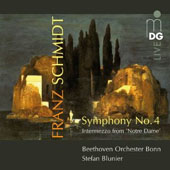
ESSENTIAL RECORDINGS

An impressive symphony that proves beyond a shadow of a doubt that you don't need to yell or slam your fist on the table to get your point across.
Franz Schmidt (1874-1939), of German-Hungarian parentage, was a child prodigy and considered to be musically clever. One of his teachers
once remarked: "The material is there, plenty of material! But the rascal will not be house-trained." Within his music, you can sense the various influences of
Bruckner for form, Richard Strauss for orchestration, Wagner for harmonic structure, and Mahler for methodical development.
This symphony, although written in four movements, is actually laid-out as one 50 minute piece of music as each movement seamlessly follows the preceding one
without a break in development. The whole work begins and ends the same way with a forlorn melody on solo trumpet. It was written as a requiem for his daughter
who had just died giving birth to her first child. That trumpet motif is what holds the symphony together so masterfully, as Schmidt slowly and patiently develops that
motif to evolve into a climax of crushing power at the mid-point of the Adagio (2nd movement). The following Molto vivace feels like a quick
march that suddenly collapses and dissolves into the final movement that recapitulates the whole concept of the first movement, but this time with a deeper sense of
sadness. All of this written by a master craftsman, with calm and persistent determination to see an idea through to its fulfillment, all the while traversing moments
of anguish as well as moments of great beauty. As mentioned before, a symphonic work that leaves a profound impression without having to resort to histrionics.
This live recording from January 2010 captures the Beethoven Orchester Bonn and conductor Stefan Blunier in superlative form.
Tracing out the symphony's long line with the spirit in which it was written. Tradition and innovation fused together to forge a new musical landscape. The pacing, from
start to finish is exemplary and truly lets the music reveal its inner beauty. Following the final desolate note on the solo horn, the MDG recording
technicians have gracefully omitted the applause.
Jean-Yves Duperron